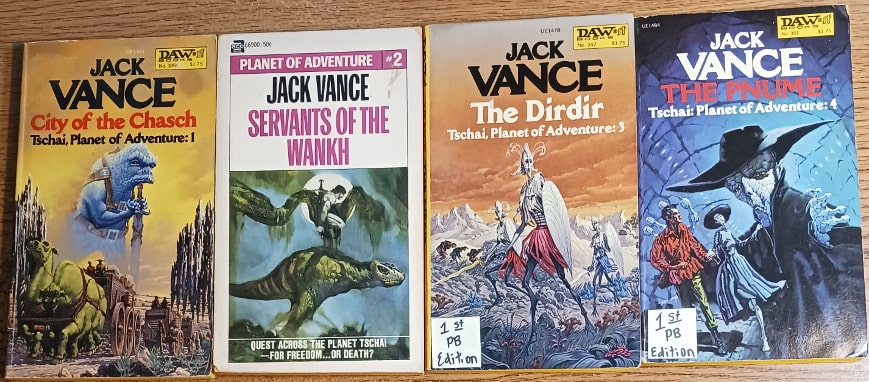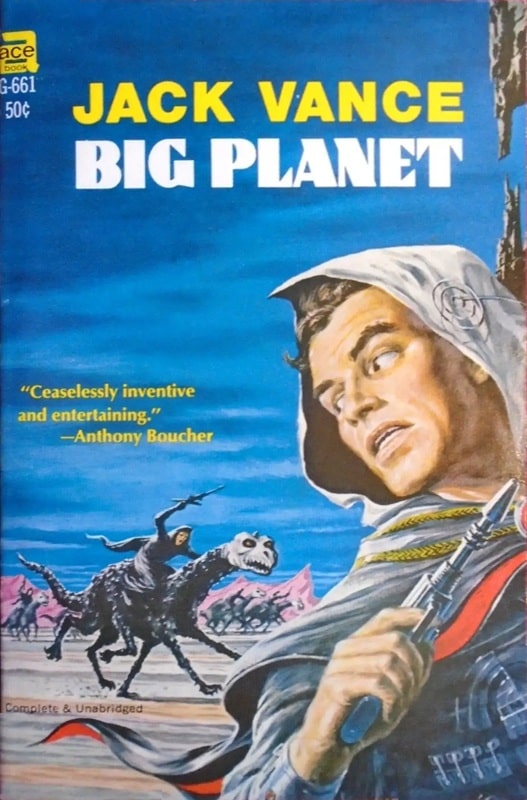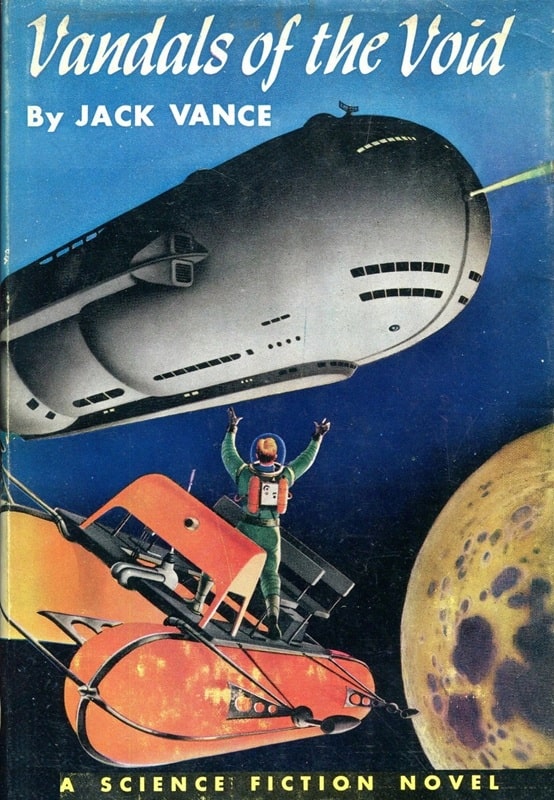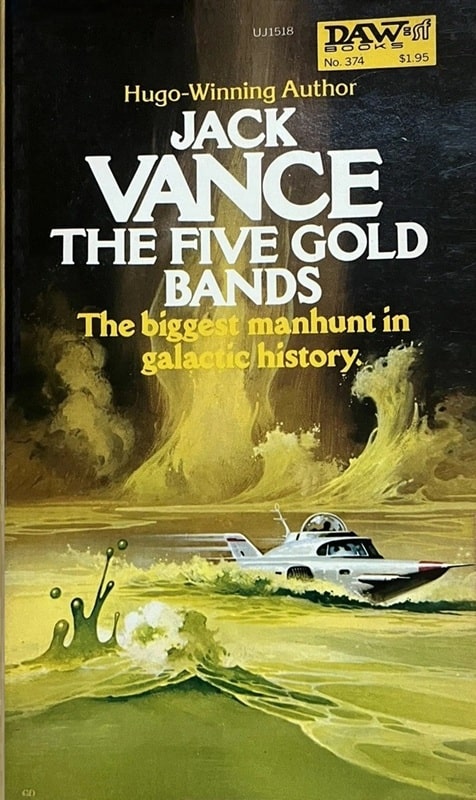The Sword & Planet of Jack Vance: Planet of Adventure

Today, we come back from our excursion into the realm of Space Opera to our home territory of Sword & Planet fiction. One of the most unique S&P series I’ve ever encountered is the four-book series by Jack Vance (1916 – 2013) generally called the Planet of Adventure series. The stories take place on a planet called Tschai, and feature an earthman named Adam Reith.
In a future in which Earth has starships, a distress signal comes from Tschai, which orbits the “dim and aging” star Carina. An Earth ship is sent to investigate and is destroyed in orbit by a missile from the planet. Adam Reith and a companion escape on a scout ship and manage to make a hard landing. The companion is soon killed by the natives and Reith is left alone. The books chronicle his efforts to survive and return to Earth.
[Click the images for planet-sized versions.]
 |
 |
Planet of Adventure omnibus edition (Orb, October 1993). Cover uncredited
Both DAW and Ace published the series, and I have a mixture of the two. My books are:
#1. City of the Chasch, DAW, 1968, H.R. Van Dongen cover
#2. Servants of the Wankh, Ace books, 1969, Jeff Jones cover
#3. The Dirdir, DAW, 1969, Van Dongen cover
#4. The Pnume, DAW, 1970, Van Dongen Cover
Tschai is populated by one native species and some humans, and by three other alien species: The books are named after the four different non-human groups, which are the Pnume (insect-like and native), the Chasch (basically reptilian), the Dirdir (bird-like), and the unfortunately named Wankh (amphibians). The humans were brought to the planet and are generally servants and slaves of the four primary races. They have been altered dramatically by their circumstances or through selective breeding.
 |
 |
Big Planet by Jack Vance (Ace, 1967). Cover by Ed Emshwiller
Jack Vance is a fine writer but he’s not one of my favorite storytellers or prose stylists. His style is unique but the word that comes to mind for his writing — to me — is ethereal. His prose and his tales do not project the concrete imagery, physical vigor, and emotional intensity that writers such as Robert E. Howard and David Gemmell do. There’s always a little more mental distance between the reader and the story — at least to me. And this is why I haven’t read a whole lot of Vance.
I did enjoy the Taschai stories, though. They are sprawling and full of exotica and decadence. One of Vance’s strengths was his world-building, and Tschai is fully realized and beautiful. It was the most complex S&P world up to that point. In fact, I wonder if the complexity of Kregen, the world Ken Bulmer created for the Dray Prescot series, might not have been modeled a little after Tschai. The Prescot books started being published only a couple of years after Vance’s series saw print, and they also feature a world with multiple non-native races.
When I first came upon the Tschai series, I assumed the star around which Tschai circles was in the real-life Carina constellation, which includes Canopus, the second brightest star in our night sky. However, the Carina constellation is mostly young, hot stars, and Carina as Vance describes it is neither young nor hot. I suspect that he named his star Carina because the term is Latin for the keel and/or hull of a ship, and Vance was a sailor.
 |
 |
Vandals of the Void (Winston Science Fiction #20, 1953). Cover by Alex Schomburg
Vance’s first published novel was Vandals of the Void, which I read from a library copy as a teenager. It had space pirates and I loved it. I eventually picked up a copy from a library book sale.
Vance is also famous for his Dying Earth series, which is not S&P and which I haven’t read — although I catch grief for it from other SF fans. I have some of those books and will eventually get to them. If I live long enough.
 |
 |
The Five Gold Bands (DAW, February 1980). Cover by Gino D’Achille
If you’re into S&P fiction, though, you should definitely give the Tschai books a go.
I’ve posted a couple of other book covers I have from Vance above. The Five Gold Bands is SF/Space Opera and this great cover is by Gino D’Achille, who did many Barsoom book covers (see the original art here).
Big Planet is also a space opera with some swords. Cover by Ed Emshwiller.
Charles Gramlich administers The Swords & Planet League group on Facebook, where this post first appeared. See all of his recent posts for Black Gate here.
Vance is one of my top five authors (along with Tolkien, Tanith Lee and two others to be named later), and I’m long overdue to reread the Tschai books.
I can imagine that someone who likes Tanith Lee would enjoy Vance. I like ’em both although they are not in my top 5 list. Have you ever read M. John harrison? he is somewhat like Vance and Lee I think.
I own a number of Harrison’s Viriconium books, but they’ve never quite gotten to the head of the queue. Someday.
I only read the first 2 but they were very well written
Not only do I have the Tschai books, but some years back an unabridged recording of the series was released on audio CD. I had a chance to listen to it on a driving trip to Toronto for vacation a couple of years ago. I would recommend it to anyone who has about a few days to spare.
wow, never even heard of that
‘Jack Vance is a fine writer but he’s not one of my favorite storytellers or prose stylists. His style is unique but the word that comes to mind for his writing — to me — is ethereal. ‘
Ethereal is the last word that comes to my mind to describe Vance as a writer when in a scene where, for instance, the protagonist Reith is threatened by imminent castration by tribal priestesses or must counter with the sword at hand — which may be wildly inadequate for the purpose — a far more massive opponent who means to hack him apart, then details exactly the sequence of desperate calculations and actions that Reith undertakes to prevail and his opponent’s often unexpected countermoves, and finally the bloodiness of the death that finishes the confrontation.
Likewise, Vance’s presentation of Tschai’s cultures, peoples, terrain, weather, and seas — even down to the quality of the light there at different times –isn’t sustained primarily by throwing around adjectives and adverbs to create an ethereal haze of mood — though those adjectives and adverbs may be there — but by the investment of his imagination in working out in extraordinary detail his world and then picking the language to describe it.
SF critics have problems dealing with Vance because he was a writer whose work provides them with few of the usual handholds to gain intellectual traction and find things to say about it. Indeed ,he worked to be that kind of writer. But merely as a stylist — and a good writer is more than that — only J.G. Ballard and Gene Wolfe, and maybe Lucius Shepard, come to my mind right now as having been in Vance’s league. As a writer he was one of the very finest that SF has produced by a long way.
I would also eschew “ethereal” for Mr. Vance’s style, but I think I what Mr. Gramlich is describing is how mannered the style can be, which does put the reader at a remove from the action. It can feel as though the characters are commenting on their actions (as they occasionally do directly) from the outside, more than they are experiencing their actions from the inside. As opposed to the more viscerally direct work of Mr. Howard’s Conan stories, the Vance works tend to the intellectual.
Eugene, I think you’re right. it’s difficult to describe his writing and it isn’t a simple thing, but even in his more graphic moments he never feels as “visceral” with his wordings.
perhaps we’re using ethereal a little differently. “Turjan watched her disappear through the shafts of jewel colors.” “Orange lanterns floated in the air, and from the balconies dangled flower chains and cages of blue fireflies.” “A pale white form, quiet in the shadow across the river.” I love this use of language but there is a certain delicacy to it. Of course, not all his work is the same. He varied his prose well, but certain phrases that stand out for me have what I’d describe as an ethereal feel.”
Hi Charles, I am greatly enjoying your Sword & Planet series of articles and frequently noting ones that interest me for future consideration for my TBR. In the case of today’s article I happen to be in the midst of enjoying Vance’s Planet of Adventure series having just finished book 3 The Dirdir. Much as I enjoy reading Jack Vance having additionally read three of The Dying Earth volumes and some of his short stories I cannot disagree with your observations of some of the particularities of his writing style. Still I enjoy his imaginative world building. Please continue this wonderful exploration of the many worlds of Sword & Planet stories!
Thanks, Ralph, I appreciate it. Glad you are enjoying.
Huh. I don’t think it would ever have occurred to me to compare Vance and Howard. What an interesting mental exercise.
…closest I’m getting is that, stylistically, Vance:Weaver::Howard:Stone-Dresser.
Good on you for being able to put actual words to your sense of the differences.
Howard and Vance sometimes tread the same basic story ground but their approaches are certainly very widely different.